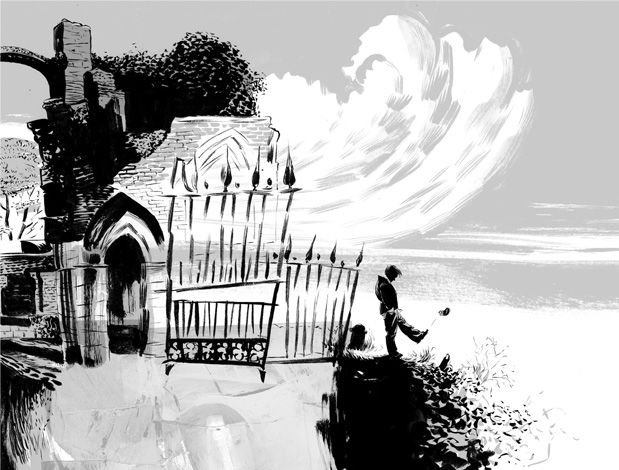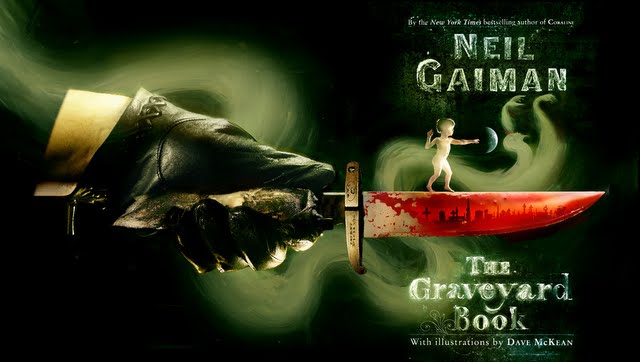So a little while back I finished reading Neil Gaiman’s The Graveyard Book, over 300 pages of prose with chapter-break illustrations from Dave McKean. It was released last year by HarperCollins in the US.

The high-concept pitch for the novel would probably be “What if Harry Potter were raised by ghosts in an English graveyard?”
And it would be silly for a number of reasons, the least of which are that the book’s central character, Bod, isn’t a wizard, and that the book was awarded the 2009 John Newbery Medal for the Most Distinguished Contribution to American Literature for Children, which to some is recommendation enough.
But not everyone knows about that award. Nor is everyone familiar with the book’s author, Neil Gaiman, despite his being a celebrated writer of both adult and children’s fiction in prose and comics — including The Sandman, which spurred the rise of DC’s entire Vertigo imprint, and the novels from which the recent films Coraline and Stardust were adapted — themselves award-winning. Nor does everyone realize that much good children’s fiction is accessible and enjoyable to adults as well. (Nor does an award mean anything other than that a certain number of people in a given position at
a certain time consider a work award-worthy, I grant you.)
For those of you who are Gaiman devotees, I offer links to...
• Neil’s journal, part of his official website, of which you are probably already aware. I don’t check in nearly as often as I’d like, putting it in good company with the blogs and websites of many of my friends and favorite creative persons. He also has a website aimed specifically at young readers, called Mouse Circus.
• A short interview with Neil on the in-vogue topic of vampires at the EW website,
tying into the cover package of the magazine’s latest print issue.
• Flights of fancy written by Neil [bad link] to accompany the set of Mythical Creatures stamps created by his frequent collaborator McKean and issued in June by the Royal Mail of Great Britain. McKean’s own website still hasn’t gone live but it looks neat, and from it I learn that The Graveyard Book and David Almond’s The Savage, which also features McKean’s artwork, have both been awarded medals by the Junior Library Guild. I wasn’t aware of The Savage, and it sounds fascinating.
Whether the above is just typical tangent-flying on my part or my subconscious mirroring my experience reading The Graveyard Book I don’t know. After reading the first chapter, I was intrigued, but the book sat on my night table awhile as I reached for something else instead; sometimes I’m unable to read prose, and specifically prose fiction — which requires a different kind of concentration than nonfiction — and sometimes I’m unable to read anything of substance altogether, but that wasn’t the whole issue. I returned to the book for another couple of chapters and again it seemed to be moving forward, rather disjointedly, without really going anywhere.

Only when I got about halfway through did I realize that the seven-chapter novel was really a set of linked stories, and right around that point it also became an engaging page-turner that I finished in one night.
The first chapter introduces us to the boy soon known as Nobody Owens, Bod for
short, and tells us how he came to be raised by ghosts in an English graveyard. Subsequent chapters jump ahead in years and find Bod taught certain tricks by his extended family that most living children have no hopes of mastering while also being schooled in more traditional disciplines by the undead Silas, who resides in the graveyard’s abandoned chapel, and the infrequently visiting Miss Lupescu. As Bod grows older, more characters are introduced and recur, and a tapestry is woven that finally begins to make The Graveyard Book more than the sum of its parts.
While his mentor Silas is a crucial figure, it’s unsurprising that women become increasingly important to Bod’s story, from a live, lively Scottish lass to a young witch buried in unconsecrated ground to a manifestation of Death itself. Like the later Harry Potter novels, this isn’t fiction for the younger young readers, as it involves terror and murder, but rare will be the parents reading the book to determine its appropriateness for their children who will come away regretting the experience. Despite earlier chapters’ failure to grab me the way I expected, I was quite literally thrilled as the
book reached its climax and coda.
Since Harry Potter has again been referenced I should explain why it’s particularly odd to invoke him in an imagined pitch for The Graveyard Book.
Foremost perhaps is that children’s fiction and fantastic literature in general have a long tradition of orphaned children who are either taken from or placed into families with extraordinary, often supernatural, circumstances and abilities. Harry Potter is just a convenient reference point for folks unfamiliar with the monomyth concept as popularized by Joseph Campbell.
More specifically, however, there’s a bespectacled, brown-haired British boy with an owl and a destiny who’s tutored by powerful magicians by the name of Tim Hunter.
Tim was created by Neil Gaiman with artist John Bolton for a DC Comics miniseries called The Books of Magic during Gaiman’s tenure on Sandman; the boy’s appearance was based on that of Bolton’s son. There have been those who’ve accused Harry Potter of being a deliberate swipe of Tim Hunter and those who’ve charged Neil himself with making such accusations, but Neil has debunked both topics as meritless. Last year he quoted decade-old comments of his on the subject, which lamented chiefly that the topic would likely never die no matter what he said and that the Potter phenomenon meant that Tim Hunter probably couldn’t be a bespectacled, brown-haired British boy in a movie adaptation of The Books of Magic, lest audiences think that Hunter was ripping off Potter; this is even more ironic since DC’s corporate sibling Warner Bros. Pictures held the movie rights to both characters.
The Graveyard Book will be reissued in paperback this October by HarperCollins, which has also prepared a PDF reading-group guide and produced an unabridged CD
of the book as read by Gaiman. In addition to the US hardcover, there exist three editions released in the UK by Bloomsbury Publishing and a signed, limited-edition hardcover from Subterranean Press designed and illustrated by Dave McKean with copious supplementary material.

Cover art for The Graveyard Book’s main edition from HarperCollins, an interior illustration,
and wraparound jacket art for the limited edition from Bloomsbury all © 2008 Dave McKean.
Related: A Wing and a Prayer • Dragon Tale
• A Curious Case of Bedrooms and Buttons

I've been eyeing this book since its release, but when I saw your review I finally picked it up. It's my first foray into a Gaiman book, but am enjoying it, though only a chapter in. Thanks for the little extra push :)
ReplyDeleteYou're welcome.
ReplyDeleteI'm sorry; I spaced out watching the bunny bounce. That happens sometimes.
haha! I so fell in love with this icon. Keep debating putting something else up instead, but then I watch it and change my mind :)
ReplyDeleteI gotta admit, at times it's really distracting on Nikki's comment pages -- trying to read some dense comment with a repeatedly hopping bunny in my peripheral vision. But it's cute. For the longest time I thought your old icon was a little Wall•E-ish robot head surrounded by a dark circle and white space, until one day I looked at your profile and realized that it was you holding a camera behind some kind of peephole.
ReplyDeletehehehe! Yeah, my old icon was from the time our house decided to lock me in the bathroom and we had to completely dismantle the door because the hinges were on the inside, so my sister decided to take a picture of me looking out waiting for the screwdriver.
ReplyDeleteso after all this conversation I decided to change my profile pic...
ReplyDeleteI'm sorry if my overly negative remarks made you self-conscious about the bunny icon. Very often I have to adjust the sizes of windows in my browser to crop out animation on a webpage or if that doesn't work actually position part of the page off my screen entirely. So I'm particularly sensitive to that sort of thing.
ReplyDeleteNo, it wasn't you...well not exactly :) I've been debating over changing it for a while and decided a change was in order. This conversation just helped tip the balance in favor of the change :P
ReplyDeleteNow getting back to Gaiman: I know you're into Lost (just a little) and Harry Potter, and if you like supernatural fantasy you might enjoy Good Omens, a novel in the Douglas Adams vein that he wrote with Terry Pratchett 20-ish years ago. I had practically forgotten about it until the other day, since I think of his prose work as mostly coming after he'd done a good deal of comics -- Sandman in particular -- yet before his first short-story collection and Stardust he did the very well-received Omens. I honestly remember it being a little precious, but still quite enjoyable; whether The Graveyard Book is indicative of it I couldn't tell you this long after reading it. And if you ever want more comics recommendations, just let me or Batcabbage know. 8^)
ReplyDeleteNo contest, Batcabbage wins any battle of the icons anyway. I need to do something about my own pretentious B&W Author's Photo thing, but I keep putting off swapping in another pic because I have something in mind to use that isn't scanned yet.
ReplyDeleteAh hahahaha! Seriously, BatCabbage and BatKitty totally win the icon contest, hands down...
ReplyDeleteI've missed you and BatCabbage over at the rewatch...and Benny's just catchin up.
But there are some new faces that have been tons of fun.... My life is just too busy :)
Thanks for the recommendation on Good Omens. I'll have to add it to my massive and ever-growing list of "to read".
Working in a book store means you never run out of recommendations, but you rapidly run out of time (and money :P)